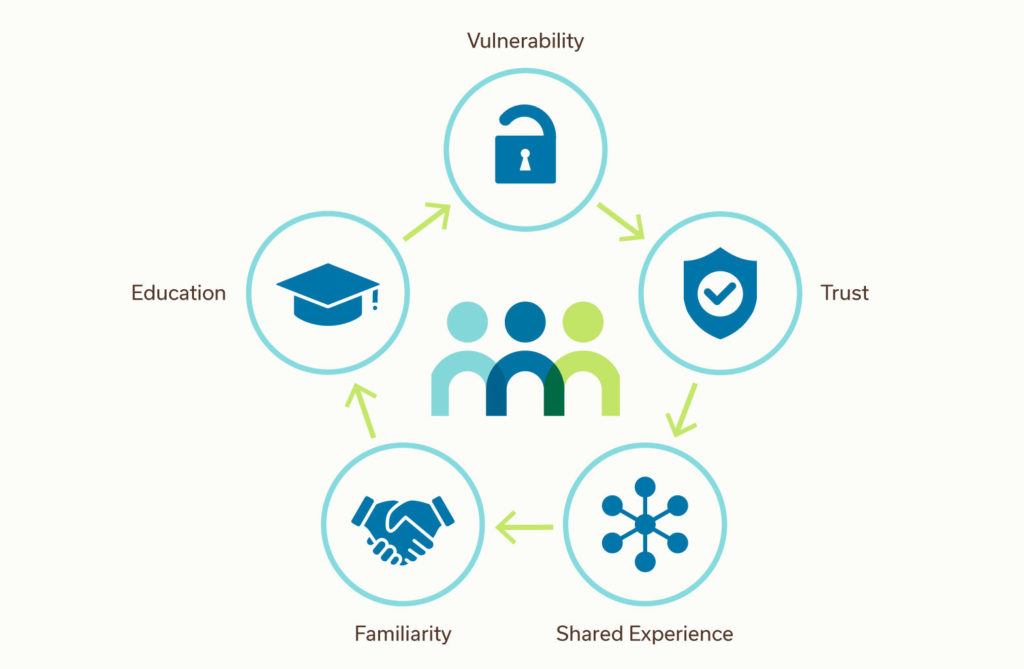In today’s family business environment, there are more generations working together than ever before. In fact, many workplaces include members of five different generations, ranging from Traditionalists to Generation Z. Family enterprises of all sizes are facing new challenges and opportunities in leveraging the strengths of the incoming generation. A common question that we receive in our work with families is: “How do we help our next generation to become a good team?”
Creating strong next-gen teams is a highly worthwhile investment of time and energy to support the continuity of both the family and business. The investment of time in planning and budgeting of resources for shareholder development can produce significant returns in unity and harmony for future generations. Consider the following examples:
The Randolph family is in the middle of generational transitioning from sibling owners to cousins. Due to a variety of circumstances, this cousin group has spent very little time together, neither as a family nor in a business setting. As a result, when questioned on their potential interest in participating in the family business, the group was hesitant, uncertain and skeptical about their ability to make any joint decisions. They view each other as strangers, with low levels of trust and confidence in one another.
In contrast, consider the Allegre family and their next-generation cohort. The Allegres meet twice a year as a group of family-owners in a location that allows for a mix of business and interaction. They dedicate time at each meeting to business, education, and fun as a group. The family has placed an emphasis on building relationships together and ensures that their activities are appropriate for a mix of generations. They invest time and resources into their group activities at meetings, and over the past few years have engaged in family Olympics, river rafting, community clean-up events, and tours of their manufacturing facilities. They also have generation-specific activities that are designed to help each age group spend time together to build familiarity and trust in both business-focused and social settings. The Allegres have built a cohesive next-generation team through their commitment to fostering relationships in the family, and this has helped them come together to be an aligned shareholder group that can strongly support the growth of their business.
Team-Building in Family Businesses
Long-lasting relationships are vital to the success of any multigenerational family business. It is important for the next generation of leadership to know each other, not just as business partners or coworkers, but also as family members. Appreciating the unique challenges of multi-generational families is vital in harnessing future opportunities.
Some of the most common factors that influence next-gen team building are:
- Differing world views and cultural proclivities defined by each generation that influence the family dynamics and relationships.
- Families that are divided into branches focusing on differences versus the concept of “one-family” centered on the things they share in common.
- A spread of ages within one generation. Often generational cohorts are not as homogenous as we may treat them and can have decades of difference in ages in just one generation.
- Varied levels of wealth according to work history, career choices, ownership stakes, and family branch history.
- A sense of dedication to responsible stewardship of the family enterprise(s). This may manifest itself in meeting attendance, participation, and overall engagement.
Key Elements of Next-Gen Team Building
Given the various challenges outlined here, how do we turn them into opportunities for team building? In our work with multi-generational business families, the ones with the strongest relationships seem to create the strongest team mentality and group identity. So how do we nurture solid, sturdy relationships? We see five main foundational characteristics of successful, productive relationships that are critical to include in next-gen team building:
- Vulnerability
- Trust
- Shared experience
- Familiarity
- Education
Vulnerability
A fundamental way of building relationships is by having some element of vulnerability amongst the group. Vulnerability means the capability to be honest, forthright, and emotionally available in the relationship. The Merriam-Webster dictionary definition takes this a step further, defining vulnerability as “capable of being physically or emotionally wounded.”
Some ways to safely open family members include sharing “learning by failure” stories, things in your life that you regret, and gratitude letters in which family members share what they appreciate about one another. We fully acknowledge that being vulnerable among family members can push the comfort zone of many people, and so this must happen in an environment that is safe. A code of conduct can help provide some guidelines for how family members interact in these situations. In many cases, a professional facilitator can help create an atmosphere in which family members can deepen their vulnerability, even if that is in small degrees. To engage in any amount of vulnerability, there must be a foundation of trust amongst the family.
Trust
Stephen Covey writes in his book The Speed of Trust1: “Trust is equal parts character and competence.” Trust is the both explicit and implicit understanding among people that is gained over time by being accountable and delivering on your promises. In a group, trust is a shared assurance of the team members’ individual abilities, strengths and reliability. It is a vital component of family businesses and is both a precursor and result of next-gen team building.
Shared Experience
People build relationships through shared experiences. This is true for profound experiences that bring families together, and through continuous smaller interactions (such as sharing meals together) that produce familiarity. These activities can be fun, meaningful, and educational like going bowling together, creative problem solving, personality testing, challenge exercises, or simply going on a hike together. Initiatives that are challenging and require problem-solving such as the popular escape rooms have also produced great experiences for our client families. Shared experience as a family fosters a sense of commonality and familiarity. If the event helps people learn new skills or new aspects of other family members, it is even more significant.
Familiarity
Familiarity is based on shared experience and the aspects that people have in common. As families grow and spread out geographically, building a sense of familiarity and comfort around one another becomes even more important. Familiarity in this context helps people understand the multiple roles and perspectives of being family members, owners and managers. Check-ins such as: “What is new in your life since the last time we met?” or fun games such as Two Truths and a Lie can help more distant family members build familiarity.
Education
For a group of next-generation leaders to be successful as a team, there needs to be a fundamental level of family business knowledge and education. To build this foundation, there must be an understanding around several subjects to productively participate in an ownership group including:
- Family and business history
- Business 101 covering basic financial and business skill sets such as reading a balance sheet
- Skills in decision making, communication and conflict resolution
- Understanding the family’s governance structure (family constitution, code of conduct, employment policy)
- What it means to be a family business owner including responsibilities and expectations
In our client work, we have found the most successful of family businesses find a way to incorporate family business-based education and learning specific and appropriate for each generation. This can spark teambuilding within each age group.
Bringing It All Together
We should note that these elements operate in a circular, iterative fashion. Each must be included and work in conjunction to build a successful team of next-generation leaders. When families invest in these elements, we see them building on one another in a positive cycle.

Next-Gen Team Building In Action
We offer a sample meeting agenda to help you see what these principles look like in action. We note the elements at play for each agenda step:
Day 1
8 am: Group breakfast
9 am: Meeting welcome and structured check-in [Vulnerability, Trust, Familiarity]
9:15 am: Business report [Education]
10 am: Information session on What is a Family Constitution and do we need one? [Education]
12 pm: Lunch
1 pm: Escape room activity grouped according to generation [Shared Experience, Trust, Familiarity]
4 pm: Discussion on spousal involvement at meetings and on boards. [Trust, Familiarity]
6 pm: Cocktails and dinner
Day 2
9 am: Takeaways from day 1 go-around [Familiarity, Vulnerability]
9:30 am: Full group activity – Trash clean-up project on our adopted highway [Shared Experience, Familiarity]
12 pm: Lunch
1 pm: Generational team-building activities [Vulnerability, Trust, Shared Experience, Familiarity]
- Next-gens: Ropes course
- Older gen: Waterfall hike
6 pm: Group dinner
Conclusion
Vulnerability, trust, shared experience, familiarity and education are essential for fostering successful teams within the next generation. With proper planning and attention to these elements, families can support the development of strong next-gen teams. Stronger next-gen teams produce committed ownership groups and a deeper commitment to family values.
1 Covey, S.M.R. (2006). The Speed of Trust, Free Press, New York, New York.

